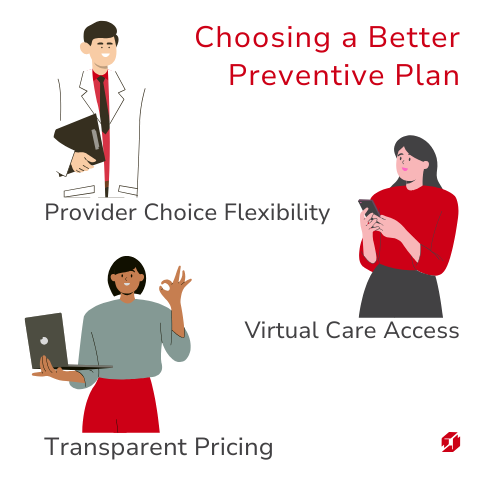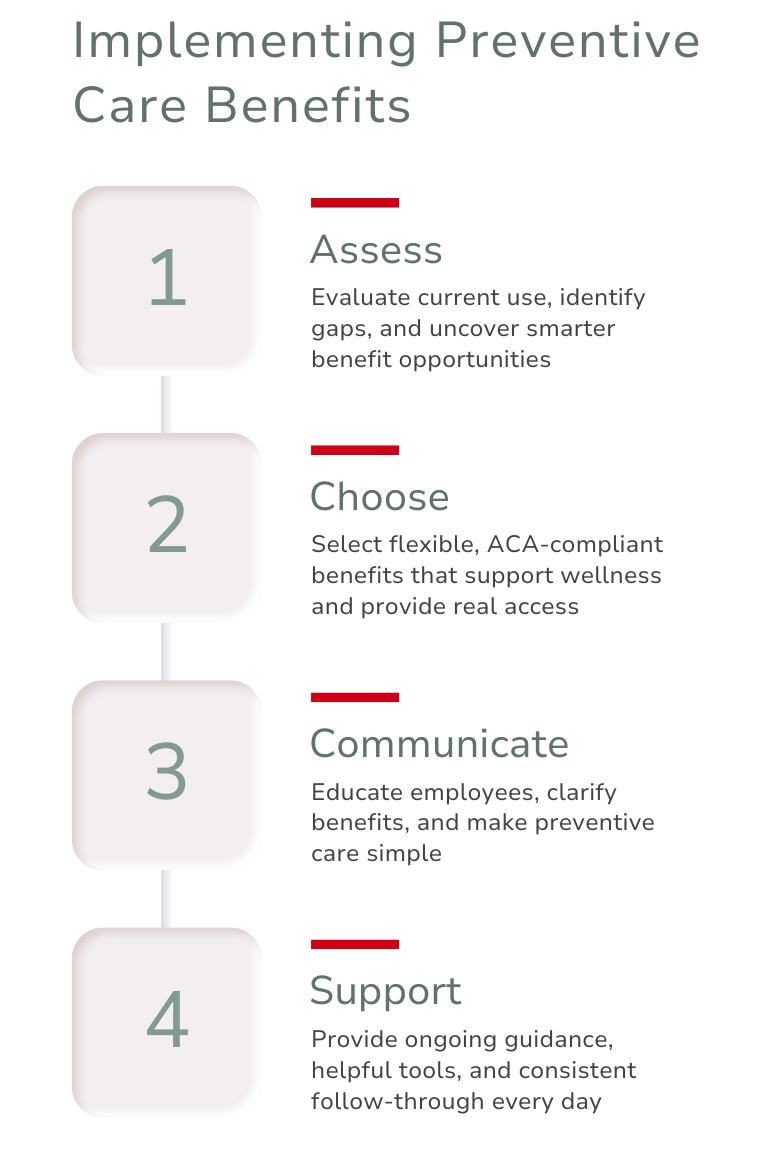Preventive Healthcare: A Win-Win for Employers and Employees
Most employees have access to preventive care—but far fewer actually use it. That disconnect can quietly cost businesses in the form of missed workdays, rising claims, and long-term health complications. The solution? Making preventive healthcare not just available, but a benefit that employees feel empowered to use.

In This Article
It’s easy to brush off preventive services as optional, but the impact is significant. According to the World Health Organization, 30-50% of cancer cases are preventable through lifestyle changes and early detection. And yet, only 8% of Americans receive all recommended preventive services each year. Employers are in a unique position to change that.
By making preventive care a core part of your benefits package, you not only support better outcomes for employees—you also gain a healthier, more productive team and a more cost-efficient business.
What is preventive care?
Preventive care refers to services and strategies designed to detect, prevent, and reduce the risk of illness before symptoms appear. It’s typically included in health plans as a set of covered services or offered as a dedicated benefit that helps employees manage their health proactively.
Examples include:
- Annual physical exams
- Cancer screenings (e.g., mammograms, colonoscopies)
- Immunizations (e.g., flu shots, COVID-19 vaccines)
- Screenings for chronic conditions (e.g., diabetes, hypertension)
- Mental health assessments
- Reproductive health services
Under the Affordable Care Act (ACA), many preventive care services must be covered at no cost when delivered by an in-network provider. This includes services for adults, women, and children.
However, not all plans offer the same level of preventive access. Some may bury services in the fine print or limit access through provider networks. That’s why choosing the right preventive care plan matters.
For more details on ACA preventive care services, visit: https://www.kff.org/aca-preventive-services-tracker/
Why offering preventive care is a win-win
For employers, investing in employees isn't just the right thing to do. It actually makes solid business sense.
For Employers
- Lower healthcare costs: Catching issues early often avoids high-cost treatments later.
- Fewer sick days: Proactive care helps reduce long-term illness and absenteeism.
- Boosted productivity: Healthier employees are more present, focused, and energized.
- Improved retention: Employees value benefits that truly support their well-being.
- Compliance with ACA regulations: For large employers, offering preventive services is required.
Preventive care can positively impact and even transform the way employees experience their health benefits.
For Employees:
- Less stress, more stability: Earlier detection reduces uncertainty and disruption.
- Improved outcomes: Catching chronic conditions or serious illnesses early can save lives.
- Better Access: No cost-services lowers financial barriers to care.
- Increased Trust: Offering meaningful benefits builds goodwill and loyalty.
Required or not, here’s why offering preventive care matters
For Large Employers (Subject to ACA Requirements)
Many group health plans include preventive services, but they’re often underused simply because employees don’t fully understand them. Without clear communication, support, or a user-friendly experience, these benefits can go unnoticed, and employers can miss out on the long-term value.
To change that, preventive care needs to be visible, accessible, and easy to engage with. Try to choose benefits that go beyond the ACA minimum, offering features like virtual care and fewer restrictions. Just meeting compliance standards isn't always enough to meet employees’ needs. When preventive care is well supported and clearly promoted, it becomes a natural part of your workplace wellness strategy and becomes a simple, effective way to support your team.
For Small Businesses (Not Required to Offer Benefits)
Small employers may not be legally required to provide healthcare benefits, but offering preventive care is one of the most affordable and high-impact ways to support your team.
Preventive care doesn’t have to mean a full insurance plan. It can be as simple as providing membership to a Direct Primary Care (DPC) clinic, offering a telemedicine subscription or virtual care access, or introducing a preventive health plan with low or no-cost screenings and services.
Even a small investment in preventive care can make a big difference for your team and your business.

How to choose a better preventive plan
Preventive care might be included in your plan, but that doesn’t mean it’s easy to use. The best plans remove barriers and offer features that actually help people stay healthy.
Look for plans that:
- Remove network restrictions
- Include virtual or same-day care options
- Offer simple access to mental health and chronic condition screenings
- Provide transparency around what’s included and the costs
- Make benefits easy to understand and use
Implementing preventive care benefits
Choosing the right plan is just the beginning. Turning it into a strategy that actually works requires thoughtful implementation, communication, and ongoing support.
Assess Your Current Benefits Package
Start by reviewing your current benefits package. Identify what’s already offered, what employees are using (or not using), and where gaps exist. If available, use tools like claims data, employee surveys, and feedback sessions to uncover opportunities for improvement and areas where preventive care can add the most value.

Communicate with Employees
Even the best plans won’t work if no one knows about them or understands how to use them. Start by educating your team on what preventive care is and how it supports their health. Then, clearly communicate what’s in their plan, how to schedule care, and where to go for help.
Build awareness into onboarding, reinforce it with email campaigns, and keep the momentum going through wellness challenges or occasional reminders. Making preventive care easy to understand and use is one of the most effective ways to boost utilization of benefits and create long-term value.
Ready to take the next step?
While preventive care is easy to overlook, making it a benefit employees feel confident using is one of the simplest ways to support a healthier, more resilient team. When care is easy to access and clearly communicated, your employees are more likely to use it, helping them stay focused, present, and better equipped to do their best work.
Whether your goal is reducing absenteeism, improving retention, or building long-term trust, preventive care delivers real value. It shows your organization is committed to wellness, invests in its people, and understands how everyday health impacts overall performance–making it a win-win for employees and employers.
At Planstin, we make it easy to put those values into action. With customizable preventive care plans and hands-on support, we help you implement solutions that work for your business and the people behind it.
Let’s build you a benefits strategy that supports prevention, performance, and people. Click below to get started today.
Explore
SUGGESTED FOR YOU




